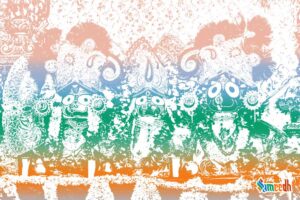Lord Balabhadra, also known as Balarama, is one of the principal deities worshipped at the Jagannath Temple in Puri, Odisha, India. He is considered the elder brother of Lord Jagannath (a form of Lord Krushna) and Devi Subhadra.

Lord Balabhadra plays a vital role in the Jagannath tradition. Depicted with a fair complexion and adorned with simple attire and ornaments, he is often seen holding a plough and a mace. Balabhadra symbolizes strength, stability, and the protective aspect of divinity. In Hindu mythology, he is considered an incarnation of Lord Vishnu, showcasing his connection to the preserver in the Hindu trinity.
Balabhadra is considered the protector and supporter of the Jagannath Triad (Jagannath, Balabhadra, and Subhadra). The trio of Balabhadra, Subhadra, and Jagannath is collectively known as the Jagannath Trinity. They are worshipped together in the Jagannath Temple, and their annual Rath Yatra (chariot festival) is a major event that attracts millions of devotees. During the Rath Yatra, Lord Balabhadra’s chariot, known as Taladhwaja or Langaladhwaja, is drawn along with the chariots of Lord Jagannath and Devi Subhadra through the streets of Puri. The Rath Yatra is a symbol of the deities visiting their aunt’s temple, the Gundicha Temple.
The plough and mace held by Balabhadra symbolize his role in agriculture (as a symbol of fertility) and his prowess in battle, respectively. These attributes highlight his multifaceted nature. Devotees believe that seeking the blessings of Lord Balabhadra can provide strength and protection. Many rituals and prayers are dedicated to him, and his divine presence is considered essential for the well-being of the devotees. Lord Balabhadra is an integral part of the Jagannath tradition and holds a significant place in the hearts of devotees who worship the Jagannath Triad with great devotion and reverence.